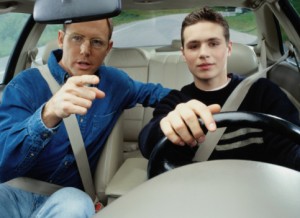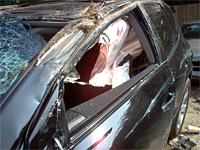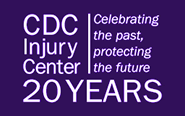Selected Category: Motor Vehicle Safety
Categories: Motor Vehicle Safety
October 19th, 2012 10:04 am ET -
Dr. Linda C. Degutis, DrPH, MSN

One of the most difficult things about working in the emergency department was making a phone call. Not just any phone call, but a call at midnight, or 2 a.m., a call to a parent who might be waiting for his teenager to return home from an evening out with friends. A call that would change a family forever. A call that no one ever wants to make. A call to say “I am calling about your son. He has been in a car crash and is in the emergency department. Can you come to the hospital? . . . Is there someone who can come with you?” It is the call that parents dread, and that we dreaded making. And, it is a call that doesn’t have to happen.
 Post a Comment -
Read more
Post a Comment -
Read more

Categories: CDC Injury Center, Home & Recreational Safety, Motor Vehicle Safety, Traumatic Brain Injury, Violence Prevention
September 11th, 2012 9:04 am ET -
Dr. Linda C. Degutis, DrPH, MSN
 I still vividly remember my days working at a trauma center, treating victims of violence and traumatic events and working with communities to help prevent violence and injuries from happening in the first place.
I still vividly remember my days working at a trauma center, treating victims of violence and traumatic events and working with communities to help prevent violence and injuries from happening in the first place.
I can clearly recall the faces and voices of children who came to the emergency department with injuries, and can still see the reactions of the parents who were told that their child had died from injuries; injuries that could have been prevented.
 Post a Comment -
Read more
Post a Comment -
Read more

Categories: CDC Injury Center, Home & Recreational Safety, Motor Vehicle Safety, Traumatic Brain Injury, Violence Prevention
September 5th, 2012 3:58 pm ET -
 Guest Blogger: Wendy Holmes, MS
Guest Blogger: Wendy Holmes, MS
Back-to-school season seems to usher a school bus load of paper into our home. It starts with a cheerful postcard showing my child’s new teacher. Then comes the packet with the welcome letter, transportation form, lunch form, contact information form, medical information form, the Parent Teacher Association form, the…well, you get the idea.
 1 Comment -
Read more
1 Comment -
Read more

Categories: CDC Injury Center, Injury Response, Motor Vehicle Safety
August 21st, 2012 1:05 pm ET -

On this Boulevard de La Madeleine, Paris France, Dr. David Sleet was struck by a car – his pedestrian story impacts the work he does for the CDC Injury Center.
Guest blogger: David Sleet, PhD
I was a graduate student in Paris in 1972 – my first solo trip to the city of light. It was dusk and a group of classmates and I made our way to Boulevard de La Madeleine to shop. The narrow, seemingly pedestrian-friendly boulevard was alive, and it was cluttered with tourists and Parisians taking in the last minutes of light.
 2 Comments -
Read more
2 Comments -
Read more

Categories: CDC Injury Center, Home & Recreational Safety, Motor Vehicle Safety, Traumatic Brain Injury
June 13th, 2012 10:19 am ET -
We are excited to see how injury and violence professionals, students, and the general public can showcase what injury and violence prevention looks like in their own communities through the “Seeing My World through a Safer Lens” video contest. This challenge will award $500 per category (Student View, Injury and Violence Professional View, and General Public View) for the video that best reflects a prevention story about Violence Prevention, Home and Recreational Safety, Motor Vehicle Safety, or Traumatic Brain Injury.
 1 Comment -
Read more
1 Comment -
Read more

Categories: CDC Injury Center, Motor Vehicle Safety, Traumatic Brain Injury
June 5th, 2012 2:08 pm ET -
Guest blogger: Jessica Burke

Jessica's car after the crash
I could be a web developer anywhere. So, why do I choose to work at CDC’s Injury Center?
It’s because I know what it means to suffer a Traumatic Brain Injury (TBI). And I know how important it is to help prevent other people from going through what I went through one Thursday in August 2005.
 9 Comments -
Read more
9 Comments -
Read more

Categories: CDC Injury Center, Motor Vehicle Safety
April 9th, 2012 2:11 pm ET -
Guest Blogger: Lee Annest, Ph.D, MS

Dr. Lee Annest
You see crashes on the roads all of the time, but you don’t ever think it’ll actually happen to you. My wife and I were driving down a crowded interstate in Atlanta a couple of years ago when a speeding car swerved and crashed into our van, and then we were hit by three other cars going 65 mph. The fact that we walked away with only stiff necks and minor injuries seemed like a miracle….or was it? We were wearing our seat belts and our van took the brunt of the impact because of good engineering and front and side air bags. I do what I do at the CDC Injury Center because I believe that little things like wearing seat belts and air bags really do save lives, and I have good reason to believe.
 3 Comments -
Read more
3 Comments -
Read more

Categories: CDC Injury Center, Home & Recreational Safety, Injury Response, Motor Vehicle Safety, Traumatic Brain Injury, Violence Prevention
January 23rd, 2012 4:29 pm ET -
Dr. Linda C. Degutis, DrPH, MSN

Please visit the CDC Injury Center 20th Anniversary web site for toolkits, talking points, and other resources to help us commemorate our 20 years, and to spread the word about injury and violence prevention.
I have many stories that I could tell about injuries and violence, from both my professional and personal lives. One of my nephews was diagnosed with depression when he was in high school. He was treated, eventually finished school, and graduated from college at the age of 25. He was accepted to law school, but tragically, he died by suicide shortly after receiving his acceptance letter. Working in trauma and emergency care for many years, I saw the impacts that deaths and injuries had on families like mine. These experiences compelled me to do something to prevent other families from suffering. Being at CDC where so many people are dedicated to preventing these kinds of tragedies gives me an opportunity to ensure that fewer families will experience such loss and disruption.
 2 Comments -
Read more
2 Comments -
Read more

Categories: CDC Injury Center, Home & Recreational Safety, Injury Response, Motor Vehicle Safety, Traumatic Brain Injury, Violence Prevention
April 14th, 2011 3:24 pm ET -
Dr. Linda C. Degutis, DrPH, MSN
 Last week, National Public Health Week (NPHW) focused on injury and violence prevention – keeping people safe and realizing the goal of ensuring that people live injury-free. It was a week where a great deal of attention was focused on injury and violence and the health and societal effects of both. The joint Safe States Alliance, Society for the Advancement of Violence and Injury (SAVIR) & CDC’s Injury Center Conference in Coralville, Iowa brought together over 350 injury and violence prevention practitioners and researchers, creating a forum for research informing practice and practice informing research, and an opportunity to explore evidence-based policy and practice. It was a great week, and the first time that NPHW focused on injury and violence prevention.
Last week, National Public Health Week (NPHW) focused on injury and violence prevention – keeping people safe and realizing the goal of ensuring that people live injury-free. It was a week where a great deal of attention was focused on injury and violence and the health and societal effects of both. The joint Safe States Alliance, Society for the Advancement of Violence and Injury (SAVIR) & CDC’s Injury Center Conference in Coralville, Iowa brought together over 350 injury and violence prevention practitioners and researchers, creating a forum for research informing practice and practice informing research, and an opportunity to explore evidence-based policy and practice. It was a great week, and the first time that NPHW focused on injury and violence prevention.
 9 Comments -
Read more
9 Comments -
Read more

Categories: CDC Injury Center, Home & Recreational Safety, Injury Response, Motor Vehicle Safety, Traumatic Brain Injury, Violence Prevention
April 4th, 2011 8:00 am ET -
Dr. Linda C. Degutis, DrPH, MSN

Dr. Linda C. Degutis, DrPH, MSN
Looking back at my experience in the field of injury prevention and control, I can easily see how important partnerships have been in our efforts to decrease the toll that injury takes on people of all ages. We have come a long way over the past few decades, but face new challenges in enabling people to live injury free lives. We face the challenges of an aging population, with increased risk of falls; various forms of violence, including violence among youth which so often has its roots in early childhood, and has health impacts far beyond the immediate effect of injuries related to violence; motor vehicle related injuries that affect vehicle occupants as well as those who share the road with motor vehicles; emerging problems with narcotic prescription drug abuse and overdoses; suicide and injuries with long-term effects among our troops who are returning from their missions. While efforts in these areas may involve different partners and different approaches, they are all amenable to a public health approach.
 4 Comments -
Read more
4 Comments -
Read more


 I still vividly remember my days working at a trauma center, treating victims of violence and traumatic events and working with communities to help prevent violence and injuries from happening in the first place.
I still vividly remember my days working at a trauma center, treating victims of violence and traumatic events and working with communities to help prevent violence and injuries from happening in the first place. Guest Blogger: Wendy Holmes, MS
Guest Blogger: Wendy Holmes, MS



 Last week,
Last week, 

